TEMPLES OF ORISSA
The Orissa temples have their own distinct style which gradually evolved into a more elaborate plan, highly decorative plastic figures and taller sikharas.
The Mukteswara temple belonging to the 19th century AD. is the most elegant example of the changing style and is said to be “A gem of Orissan architecture in sandstone”. It is a small temple and stands 10.50 metres high. Every available inch of the exterior wall is decorated with intricate sculptures or graceful figures in different poses and depict stories from the Panchatantra written by Vishnu Sharma of Orissa. The ceiling of the Hall of Audience has a beautiful canopy of an eight-petalled lotus with an icon sculpted on each petal. The vertical ribbed shikhara is made up of towers which are miniature shikharas. The elaborately carved stone arched gateway or torana in front of the temple is an exquisite piece of architecture and is a particular feature of this temple only.
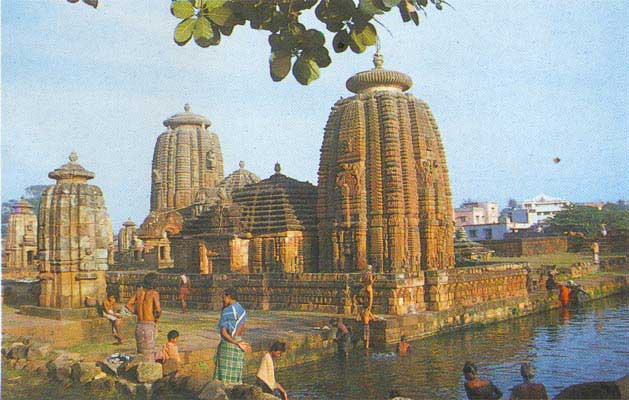 |
| Mukteswar Temple, Bhubaneshwar. (Picture courtesy Orissa Tourism) |
The temples of Bhubaneshwar and Jagannath Puri built between the 11th and 13th centuries AD are typical specimens of the Orissan style of architecture. The characteristic features of these temples are the Viman or sanctuary, the Jagmohan or assembly hall, the Nat mandir or dancing hall and the Bhog mandir or hall of offerings. The halls usually have no pillars. The exterior of the temples is adorned with sculptures whereas the interior is bare.
The most famous temples of this type are the Rajarani temple and the Lingaraja temple in Bhubaneshwar, the Jagannath temple in Puri and the Sun temple in Konark.
 |
| Rajarani Temple, Bhubaneshwar (Picture courtesy Orissa Tourism) |
The Lingaraja temple was built in the 11th century AD by a ruler of the Ganga Dynasty. It has all the typical features of an Orissa temple. Situated in a quadrangular enclosure it has a vimana and a Garbha Griha
The construction over the garbha griha is the shikhara - a lofty ribbed curvilinear spire, 55 metres high which curves in at the top and is surmounted by an amalaka or large rounded block of stone. On this stands the golden vase shaped Kalasa with a trisul. The sanctum rests on a basement of fine mouldings. The lower part of the wall on three sides has niche projections with icons of Ganesh, Parvati and Kartikeya. Opposite the main shrine is the assembly hall The tiers of the roof have exquisitely carved friezes of processions and other scenes. Other structures are the Nat mandir and the Bhog mandir. There are a number of smaller shrines around the main temple. The exterior of the shikhara like all Orissan temples has horizontal mouldings and small carved replicas of the spire filling the spaces in between.
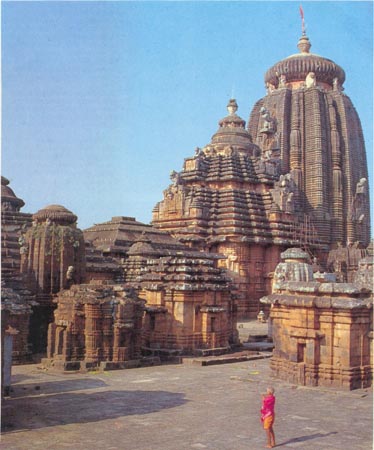 |
| Lingaraj Temple, Bhubaneshwar (Picture courtesy Orissa Tourism) |
The Jagannath temple in Puri is a larger replica of the Lingaraja temple. It was built in the 12th century AD and has a tower 65 metres high.
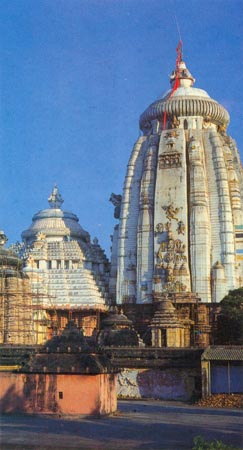 |
| Jagannath Temple, Puri (Picture courtesy Orissa Tourism) |
The greatest achievement of the Orissa style is the Sun Temple at Konark about 32 km. from Puri. It represents the final phase of Orissa temple architecture. It was built by Narsingha Deva of the Ganga Dynasty in the 13th century A.D. Dedicated to Surya the Sun God, it is called the Black Pagoda. Shaped like a Ratha or chariot drawn-by seven richly caparisoned horses in motion it represents Time - the Sun God driving across the sky. The basic structure is an immense terrace with twelve huge wheels, each nearly 3 metres high on either side. The temple stands in a courtyard. Entrance to it is by a flight of steps, flanked by two huge sitting elephants with a huge lion on each of them. Though the spire of the temple has collapsed the pyramidal roof of the Hall of Audience is intact.
The outer walls of the temple are decorated with exquisite sculptures of dancers in various poses, musicians, lions, horses, elephants etc. covering every aspect of life besides erotic figures which are believed to have been sculptured due to the rampant influence of tantrism at the time. The three main images of Surya in green chlorite are pieces of sculpture with elaborately embellished carvings all round from the plinth to the tiered pyramidal roof has rightly been described as a “Poem in Stone”.
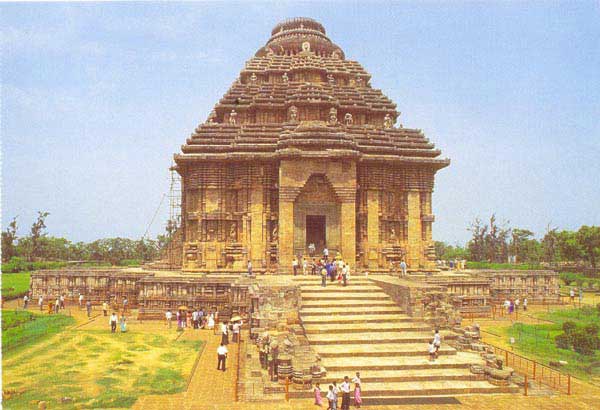
Sun Temple, Konark, Orissa
(Picture courtesy Archaeological Survey of India)
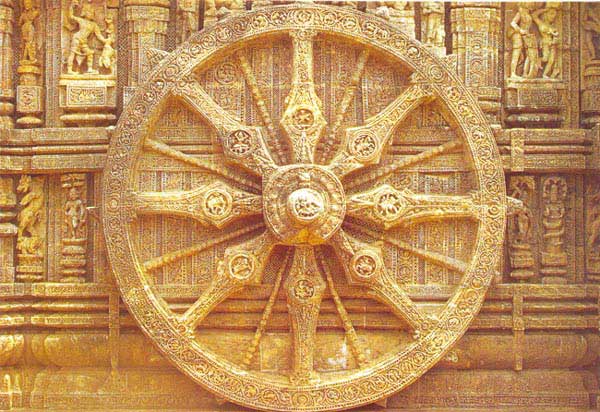
Konarak, Sun Temple, Wheel
(Picture courtesy Archaeological Survey of India)
No comments:
Post a Comment